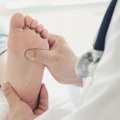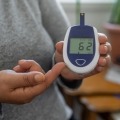How to Manage Diabetes as a High School Athlete
By Krysti Ostermeyer
 Exercising with diabetes is important, but it does provide some additional challenges. Learn how to navigate being an athlete while managing your diabetes from experts.
Exercising with diabetes is important, but it does provide some additional challenges. Learn how to navigate being an athlete while managing your diabetes from experts.
Picture it: You’ve made it on the junior varsity basketball team after practicing all summer. It’s the first game, and you are playing well. Out of nowhere, you get shaky and dizzy. You become sweaty – sweatier than you were just five minutes ago. You take that game-winning shot. You miss by a mile.
Hypoglycemia (low blood sugar) is, unfortunately, a fact of life for people with diabetes, but it doesn’t have to ruin your game.
Diabetes and Sports
“When I meet a young person who has been newly diagnosed with type 1 diabetes, who is also an athlete, a common question I am asked is, ‘Can I still play?’” said Dr. Daniel Shumer, a clinical assistant professor and pediatric endocrinologist with University of Michigan. “My answer is, ‘Absolutely.’ There are actually several professional athletes competing at the highest level of sport who have type 1 diabetes.”
Having diabetes and being an athlete can be frustrating; it takes careful planning to maintain safe blood sugar levels during exercise.
Exercise is beneficial for everyone, not just people with diabetes. Exercise has a myriad of health benefits, such as –
-
Strengthening bones and muscles
-
Maintaining weight
-
Reduces risk of cardiovascular disease and various cancers
-
Allowing insulin to work better, which improves blood sugar levels
-
Improves mental health
Exercise requires our bodies to use more energy. The type of exercise you are doing affects how your glucose levels might change. Exercise that is characterized by short bursts of energy (called anaerobic or high intensity exercise, such as heavy weightlifting) often makes glucose go up, while longer duration but low to moderate intensity exercise (called aerobic exercise, like biking or running) might make blood sugars go down. Activities that combine short bursts and longer low to moderate intensity activity (such as playing soccer with friends) may not cause as much variability in a person’s glucose levels.
Depending on how much insulin is available in the body and the type of exercise, intensity, and duration, you can ultimately experience periods of hyperglycemia (high blood sugar) or more dangerously, hypoglycemia during and after exercise. In fact, you may experience low blood glucose levels even hours later or particularly that night.
And you know what that means, right? “Everyone is different; it can be hard to predict exactly how your body will respond!”
“Managing diabetes and playing varsity hockey was not always an easy task,” said Shawn Cornock, talking about when he was a student at Marquette Senior High School in Marquette, Michigan. “I had my highs and my lows in my first year on the team.”
He said that sometimes he would have to leave practice early to take care of his health.
“By my senior year, I was able to get a better hold on what I needed to do,” Cornock said. “I would test before I went on the ice for a game and between each period. If my blood sugar was in the 100s, I knew it wouldn’t be long before I was low, so I’d drink half an apple juice [or around 15 grams of carbs] and bring the rest on the bench.”
Preventing Blood Sugar Extremes
As an athlete with diabetes, your goal is to prevent hyperglycemia and hypoglycemia. This will help you play at your best and keep you safe.
Carbohydrate timing is extremely important. Eating or drinking carbohydrates prior to and during exercise can prevent glucose level extremes –
-
First, take into account your insulin on board, if you can, and also the direction of your CGM arrows – are you trending up, down, or staying constant?
-
If it has been several hours since your last bolus of insulin, check your blood glucose level, and if you are low or trending low, consuming 10 to 15 grams of carbohydrate can help prevent hypoglycemia.
-
If you have given a bolus of insulin within the past two hours, you will likely need to consume more carbohydrates to prevent hypoglycemia. It is recommended to consume 30 to 60 grams of carbohydrates per hour when exercising.
-
If you are eating or drinking carbohydrates right before strenuous exercise, you may need to reduce your insulin dose for those carbs by about 50%. Talk to your healthcare team to determine how to insulin dose in these situations.
You may also be more insulin sensitive after exercise. It is still important to provide insulin boluses for carbohydrates consumed, but you may need to review your trends or speak with your healthcare provider or diabetes care and education specialist (CDCES) to reduce your insulin dosing to prevent severe hypoglycemia.
Mike Parks, RN, CDCES, played hockey at Finlandia University in Hancock, Michigan. During his college years he was diagnosed with type 1 diabetes. “After activity, especially intense activity, I would have to be careful with any meal bolus. I would often need to lower my dose by 50 percent,” said Parks, who continued to play hockey during college, and still plays today. “I also often required a snack before bedtime to avoid lows overnight.”
If you are prescribed a sulfonylurea, such as glipizide and glyburide, aim to consume 10 to 15 grams of carbohydrate prior to exercise to prevent hypoglycemia. These medications can cause hypoglycemia with intense exercise if you don’t consume enough carbohydrates.
“Many times, we advise athletes to take in carbs without insulin prior to practice or games to prevent hypoglycemia, and then adjust based on trial and error,” said Shumer. It is not a perfect science, and each athlete reacts a bit differently. But our goal is to keep you on the field, safe, and able to compete despite diabetes.”
Blood Sugar Monitoring
Regardless of your treatment plan, you should plan to check your blood sugar before, during, and after exercise. It is best to use a continuous glucose monitor (CGM) when you are exercising, if possible. If you use a blood glucose meter, make sure your meter is close by so that you can check your blood sugar when needed.
“I always checked my blood glucose prior to activity,” Parks said. “If at the low end of normal, I would have a 15-20 gram snack such as a granola bar, or I would have some kind of sports drink to sip on throughout. If my blood glucose was greater than 300 mg/dL, I was always instructed to check for ketones prior to activity.” You should always bring down high glucose levels prior to exercising to avoid diabetic ketoacidosis (DKA).
Many teenagers now use CGM, such as Dexcom G6, Freestyle Libre 2, and Medtronic Guardian Connect. If you are using a CGM, remember that a fingerstick still is the most accurate measure – CGM readings and fingersticks may be slightly different because of a lag time for CGMs, especially during intense activity. Because of this, it is especially important to make note of the trend arrows for your glucose to know whether you are trending high or low.
When you are monitoring your glucose levels, also be aware of insulin on board prior to treating a high. Check your insulin pump or use a bolus calculator to know how much insulin is already in your system to prevent over-correcting and risking severe hypoglycemia.
Are You Having High or Low Blood Sugar?
I review hypoglycemia and hyperglycemia at every appointment with my children and teenagers with diabetes, especially those who are student athletes.
Make sure that you know the symptoms of high and low blood sugar and that hypoglycemia in particular can sometimes have the same symptoms of exercise – such as sweating, shakiness, anxiety, or dizziness.; teach your teammates as well! For a more detailed exploration of the signs and symptoms of these two conditions, read, “Detecting the Signs: Hyperglycemia vs. Hypoglycemia.”
The type of exercise can also impact the risk of hyperglycemia and hypoglycemia. According to Shumer, “…playing sports with diabetes takes planning. Sometimes, high intensity sports cause high blood sugar when you are working hard, followed by low blood sugar later during the activity, or even several hours after stopping.”
Hypoglycemia Treatment
Always carry a quick-acting carbohydrate to treat hypoglycemia.
The “Rule of 15” is a great method for treating hypoglycemia –
-
Consume 15 grams of quick-acting carbohydrate such as:
-
Four glucose tablets
-
Four ounces of juice or regular soda
-
One tablespoon of sugar, honey, or maple syrup
-
One package of fruit snacks
-
Eight ounces of milk
-
-
Re-check blood sugar in 15 minutes
-
Treat with another 15 grams of quick-acting carbohydrate if blood sugar is not over 70mg/dl
Also, keep emergency glucagon with you at all sporting events and make sure that coaches, teammates or trainers know where it is located and how to use it should you experience severe hypoglycemia that leaves you unconscious; glucagon is a hormone that raises blood sugar levels. There are now various formulations available:
-
The traditional glucagon emergency kit uses saline to reconstitute the glucagon powder, which is then administered as an injection into a large muscle, such as the buttocks or thigh.
-
Baqsimi is an intranasal formulation of glucagon; it is easily administered into the nostril.
-
Gvoke Hypopen is premixed and uses an autojector, making it easy to deliver into the thigh.
-
Gvoke Kit is also premixed; the dose required is drawn up and injected into the thigh.
-
Zegalogue works similarly to the Gvoke Hypopen; it uses autojector technology to make delivery easy.
The Bottom Line…
Do not let fear of hyperglycemia or hypoglycemia stop you from trying out for the team, biking, hiking, swimming – or whatever your passion may be! Arm yourself with knowledge that can improve your glucose control during activity.
As Cornock said: “In the end, I figured out I had to lead myself if I wanted to lead my team. Diabetes is a team sport in itself. The only difference is the team is yourself, insulin, and your mind – if one of those things is off, then your team within yourself is off.”








